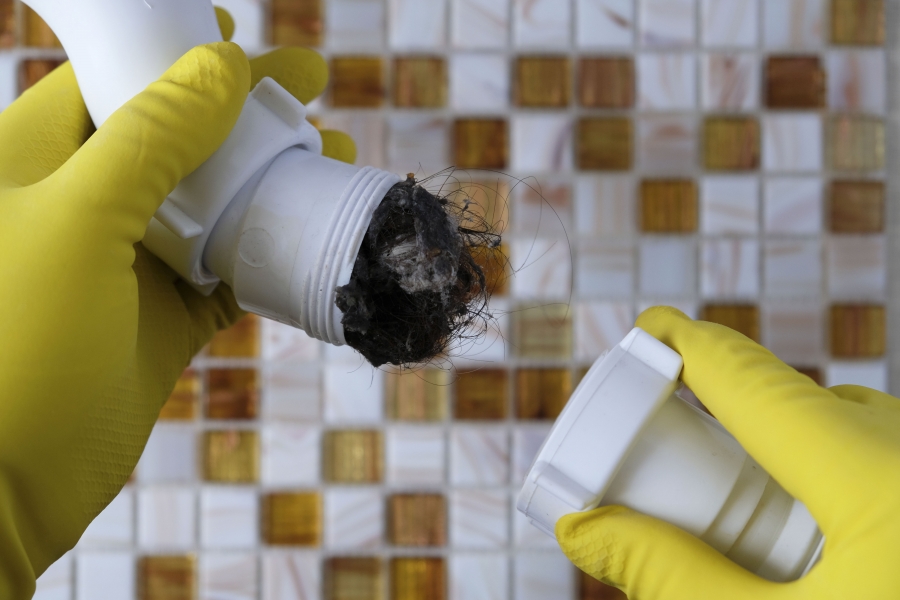Everyone will experience a blocked drain at least once in their lifetime. For some, it's surprising how frequent it can occur.
Causes of a blocked drain range from natural causes to artificial ones. Therefore, if hair, foreign objects, or silt don't cause the blockage, then the blockage is due to broken pipes, toiletries, or grease.
Blocked drains are unpleasant, gross, and nuisance. Therefore, the situation requires immediate attention because blocked drains result in foul smell and bacterial infection if it’s not immediately attended to. Since prevention is better than cure, it would be more pleasant if the drains don't block in the first place.
For you to have an idea, here are 10 possible culprits of a blocked drain:
1. Hair
Hair, which is the most common cause of the blockage, clogging the pipes comes from our bodies. When not immediately attended to, human hair will end up in the drains through the bathroom sinks, causing blockages.
To form clogs, hair binds with grease or any other sticky material. The clogs, then, stick to the side of the pipes once they get through the sink or bathroom drains. Hair will grow in size as more of it, in addition to grease or any sticky material, gets trapped from the wastewater, causing the blockage.
2. Rain and Storm
Heavy rains and storms are also a common cause for drain blockages. The blockage is not a result of the rainwater, but rather the materials carried along by the water, such as leaves, sticks, debris from buildings, and pebbles.
These materials are usually hanging in the gutters, which will then be delivered to the drains due to rain water. The blockage occurs because all these materials try to pass together at the same time though the narrow pipes.
The solution to this problem is to clean the gutters and build bigger drains.
3. Soap
Grease or fat is used when manufacturing soap. The waste soap that goes down the drain combines with the minerals in the water. The resulting substance is a hard residue referred to as scum.
Scum stains the pipes, kitchen fittings, and bathroom fittings, which can be difficult to get rid of. It's very hard for scum to cause blockage in typical drain pipes, but when the pipes are narrow, the possibility of blockages becomes higher.
4. Dirt
Dirt arises from washtubs and bathrooms as it washes off clothes and shoes, and then flows into the drains. The water should wash it away even though the dirt and silt are sometimes not washed away. The problem arises when the pressure of the water is not high enough.
The silt and dirt deposits itself along the pipes. The dirt deposited increases with time, and not long after, the space in the pipes narrows. At this point, anything can completely block the pipe.
Preventing blockage from dirt involves refraining from washing off excess dirt in tubs and sinks. Proper rinsing of the tubs and sinks can also prevent blockage.
5. Mineral Build-up
This particular kind of blockage is uncommon. For it to occur, the mineral build-up has to be consistent and persistent.
Hard water has dissolved minerals that are in high concentration compared with soft water. When these minerals build up, they can form insoluble masses, which can block the drains.
When it comes to mineral build-up, the solution is installing a water softener that works better when the water is constantly hard. The other option is to descale and remove sediment and the insoluble masses. However, this option is expensive and time-consuming if applied on a large scale, such as in a factory setup.
6. Foreign Objects
Foreign objects can find their way into pipes and drains. These objects include materials like sticks, bottle caps, cloth, plastic, coins, and jewelry.
Remember, the drains and pipes' designs are for handling human waste and toilet paper only, making other materials that deposit into the pipe system detrimental to its structure.
7. Tree Roots
Tree roots grow into sewer lines upwards from under the house. They can go as far as your toilet.
The common sign of roots in drains is the frequent clogging of the toilet or having a localized drainage problem. Note that this type of drain blockage doesn't cause waste to back up into the showers and tubs. This only indicates that the roots are getting larger, and a full checkout is necessary. The silver lining is that you'll only need a plunger to fix root blockages.
Tree roots clogging occur when there are trees and bushes left untrimmed around the house. If there isn't frequent monitoring of the drain pipes, then the damage happens.
To prevent this from happening, clear the trees and shrubs near draining pipes.
8. Toilet Paper Build-up
As much as toilet paper is friendly to the draining system, it can still clog your drains and stop toilets from flushing. The build-up happens when one doesn't use enough water to flush the toilets. Hence, the toilet paper builds up and causes a temporary blockage.
Nevertheless, one can solve this by using a plunger to shift and dissolve the toilet paper.
9. Broken and Bent Pipes.
The broken pipes provide a collecting point for the waste in the pipes. Broken pipes reduce the pressure of flow in the pipes and disrupt the movement the materials carried along.
If the pipes lie under the ground, the fractured parts may let in pebbles and sand from the surrounding into the pipe. Besides, pieces of broken pipes can also cause obstruction.
10. Animals
Last but not least, animals also cause the blockage of drains. For instance, rodents and rats can fit in pipes and drains, and when they die in there, their carcasses block the flow of the waste in the pipes.
Conclusion
There are many ways to prevent blockage of drains, and the easiest is to make sure materials that cause the blockages are nowhere near the drains.
Sometimes, the causes are unavoidable, for example, blockages caused by heavy rain, minerals in the water, and root blockages. On the other hand, other causes are a result of human behavior, such as hair, foreign objects, soap, and dirt build-up. A change in human behavior can reduce the frequency of blockages.
When prevention doesn't work, one can always check the drains. It's surprising what one can find there.









